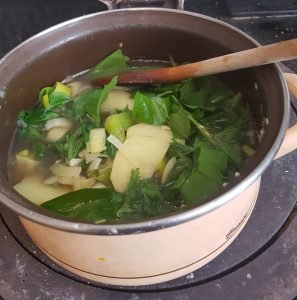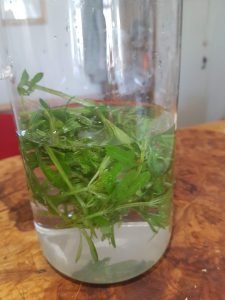Spring Tonics
 I love this time of year. Leaves are in bud on the trees and the woodland and meadow plants are just starting to come up. Before long the floor will be overgrown with ivy, brambles and ferns but, for just a few weeks, spring flowers are in bloom and the countryside looks fresh and renewed.
I love this time of year. Leaves are in bud on the trees and the woodland and meadow plants are just starting to come up. Before long the floor will be overgrown with ivy, brambles and ferns but, for just a few weeks, spring flowers are in bloom and the countryside looks fresh and renewed.
Many of the plants that are around this time of year can be used as a spring tonic. Nature has provided just what we need after winter. Before we imported food from around the world plants like stinging nettles, wild garlic, cleavers and dandelions have been enjoyed as cleansing herbs helping eliminate toxins from out body. Much cheaper and pleasant to eat or drink than some of the health shop detox products, these plants all contain lots of nutrients. They are rich in iron and other vitamins and minerals which we can use to give our immune system a boost. The plants mentioned below can be used fresh, which is best when possible, or can be frozen or dried. The exception is cleavers which should be used fresh.
Nettles
Nettles have more protein than any other native plant as well as many of the minerals our body needs to stay healthy. They can be added to soups and stews, made into tea or beer. You probably don’t want to eat them raw though as the sting is only neutralised after cooking! There is a knack to picking them without getting stung, but I find rubber gloves help.
Nettle soup

This soup is delicious and fresh tasting and full of vitamins.
Pick a small bag full of nettles, or if you want to be specific 200g
12 wild garlic leaves, roughly chopped
1 onion chopped
1 small leek
2 potatoes
2 sticks celery
1 litre of vegetable stock
Method
 Wash the wild garlic and nettles
Wash the wild garlic and nettles
Sauté the onions, leek, celery and potatoes for 10 minutes.
Add the nettle and wild garlic leaves and cook for 15 minutes or until the potatoes are soft.
Season with salt and pepper
Blend roughly with a hand blender.
Cleavers

Cleavers cold water infusion.
Cleavers are those annoying plants, also known as ‘sticky buds’ that stick to your clothes as well as cat and dog’s fur! In herbal medicine they are used to stimulate the lymphatic system as a diuretic and to promote healthy kidney function. Cleavers are also great as a spring tonic, used alone or with other herbs such as dandelion and nettles.
Cleavers cold water infusion
For a simple tonic, pick a large handful of the top fresh leaves and pour over cold water. (Approx. 25g/1 oz to a pint of water.) Leave for at least 6 hours, preferably overnight and then remove the leaves. Put in the refrigerator. Drink the water within the next couple of days.
Wild Garlic
You cannot miss wild garlic or ransoms as it is also known. As soon as you walk into the woods it is everywhere. But before you see it you can smell it – a strong garlicy onion smell, it is amazing. It comes up in late March and flowers in April. You can use the leaves, flowers and seeds, the flowers are lovely used as a garnish on salads or for pasta and gnocchi . Wild garlic can be used in risotto, as a pesto, in soups, salads and sandwiches. Wild garlic is antibacterial and aids in purifying the blood and known to lower cholesterol and blood pressure and has a high vitamin C content.
Wild garlic pesto

Wild garlic in flower
Around 150 – 200 g wild garlic leaves
Large handful of grated parmesan or other hard cheese
1 clove garlic
Juice of a lemon
50 pine nuts or walnuts toasted and chopped
100 ml olive oil
Salt and pepper
Wash and dry the wild garlic to remove any dirt or insects.
Put all the dry ingredients into a food processor and blitz while slowing adding the olive oil and lemon juice.
Season with salt and pepper and add more oil if too dry.
Store covered in the fridge for up to 2 weeks or freeze for later use.
Dandelions
These are one of my favourite flowers. Their bright yellow flowers are a joy to see in fields in the spring, but not quite so welcome in your lawn! All the plant can be used. The flowers can be made into wine or jam, the leaves cooked like spinach or put into salads or quiche and the roots dried and ground into a sort of coffee. Dandelions contain minerals such as calcium and potassium and have a very high vitamin A content. They rival spinach and broccoli in nutritional value.
 Sautéed dandelion leaf
Sautéed dandelion leaf
This is a great way to use dandelion leaves which can be quite bitter eaten raw.
Pick couple of large handfuls of dandelion leaves and roughly chop. Cook the leaves in water for around 10 minutes. Allow to cool or rinse in cold water. When they are cool, sauté in extra virgin olive oil along with a clove of garlic. You can also add pimento flakes if you like, and season with salt. Add grated parmesan to make a more substantial side dish and enjoy.
When foraging, make sure you know exactly what you are picking before eating it as some plants that grow in the same areas and look similar are poisonous. Never over pick, make sure you leave plenty of leaves and flowers for wild animals and so the plant can reproduce, and you can pick again next spring.